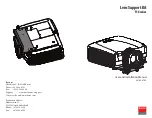
Pair of passive stereo glasses
Non-depolarizing screen
Two CRT or DLP™ projectors
With Two Projectors
One projector displays the left eye information and the
other displays the right eye information, both at a
standard refresh rate.
A
polarizing filter
mounted in the optical light path
of each projector ensures that the correct information
passes through its corresponding filter in the pair of
passive stereo glasses.
This
two-projector
approach has the
added value of
providing higher brightness
.
A light wave rotates in any direction. The specific
orientation at any given moment determines the
polarization of a light wave. By passing unpolarized
light through a polarizer, only one of its orientations
emerges.
By organizing the
polarization
oppositely
for the
left and right eye
we can direct different
information to the left and right eye, thus creating
depth perception
. As the human eye itself is largely
insensitive to polarization, changing the orientation of
polarized light does not change what we see.
Linear & Circular Light Polarization
Linear Polarization
If
light
is
polarized in a single direction
(north/south,
east/west, or even oriented diagonally), it is defined as
linear polarization. When one changes the orientation
of linear-polarized glasses by tilting his or her head, so
that the resulting orientation of polarization does not
match that of the polarization filter mounted on a
projector, there will be a loss of stereo information as
perceived by the viewer.
Nevertheless, linear polarization is a
cost-effective
technology that can produce excellent image separation
between the left and right eye, for stereoscopic
applications whereby head tilting is limited
.
Linear polarized light
Circular polarized light
2 CRT
Projectors
Although weaker in light output, a CRT projector
allows for
the highest resolution
large screen
images, with
unparalleled visual fidelity
.
Barco CRT projectors offer a
motorized polarization
filter
as an option for stereoscopic projection, whereby
the filter can be rotated away from the lens for
standard non-stereoscopic projection.
2 DLP
™
Projectors
In
high ambient light
conditions or for
very large
screen applications
, this solution is optimal.
Barco offers a range of high-quality DLP™ (Digital
Light Processing™) projectors with light output from
5,000 to 18,000 ANSI lumens. For
stereoscopic use
,
however, “
stereo lumen
” - which equals less than half
the ANSI lumen value - is the
realistic measurement
of brightness
.
Passive
Passive
3D DISPLAY SYSTEMS
Stereobrochure 02-06-2003 15:39 Pagina 5
































